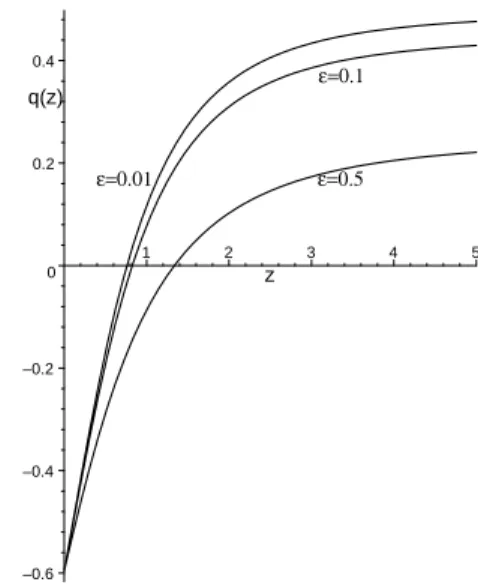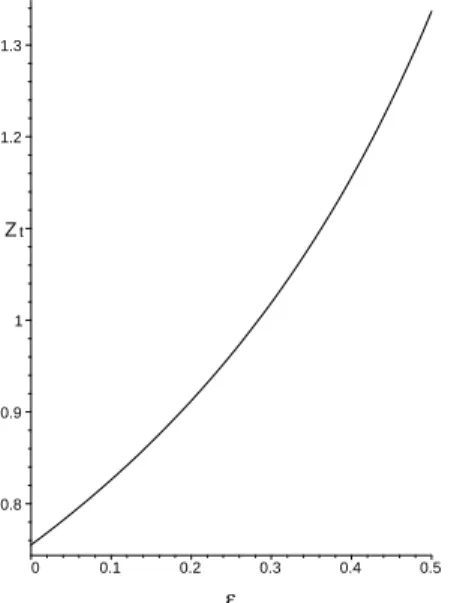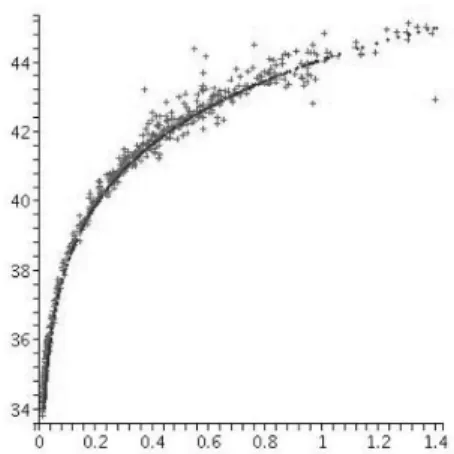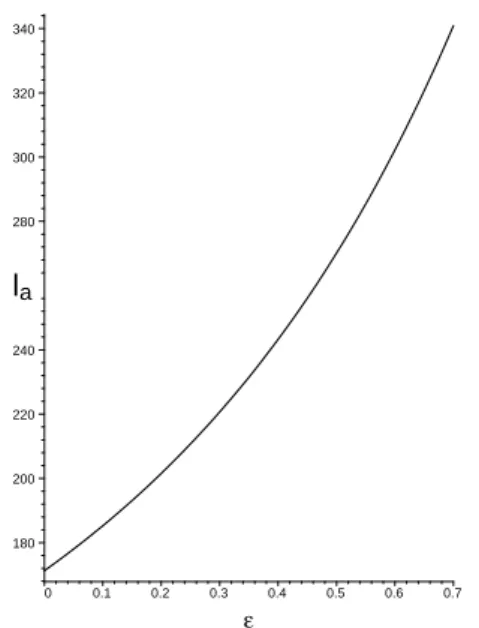Observational consequences of a dark interaction model
M. de Campos∗
Physics Department – Roraima Federal University. Av. Ene Garcez 2413, Campus do Paricar˜ana, Bloco V, Bairro Aeroporto, Boa Vista, Roraima, Brasil, 69304-000
(Received on 5 December, 2009)
We study a model with decay of dark energy and creation of the dark matter particles. We integrate the field equations and find the transition redshift where the evolution process of the universe change the accelerated expansion, and discuss the luminosity distance, acoustic oscillations and the statefinder parameters.
Keywords: Dark matter, dark energy, luminosity distance, acoustic oscillations, statefinder parameters.
1. INTRODUCTION
Before the results from supernova of the type IA observa-tions appear in the literature, that indicates an accelerated expansion of the universe, L. Krauss and M. Turner have called our attention that “The Cosmological Constant is Back ”. They cited the age of the universe, the formation of large scale structure and the matter content of the universe as the data that indicates the insertion of cosmological constant [1]. The cosmic microwave background radiation anisotropy and large scale structure, also indicates this acceleration expan-sion of the universe [2]- [4]. Besides, the analysis of 158 SNe realized by Riess et al. [5] point out the present acceleration (q<0) at 99.2% at confidence level.
The mechanism that triggered the acceleration of the uni-verse has not been identified, and the simplest explanation for this process is the inclusion of a non null cosmological constant. However, the inclusion of cosmological constant creates new problems. Some of them are old, as the dis-crepancy among the observed value for the energy density of the vacuum and the large value suggested by the particle physics models [6], [7]. In spite of the problems caused by the inclusion ofΛ, the cosmological scenario withΛhas a good agreement with respect to the estimate age of the uni-verse, the anisotropy of the microwave background radiation and the supernova experiments. Besides, making several as-sumptions concerning with the spectrum of fluctuations in the early universe and the formation of the galaxies, G. Ef-stathiou suggests that the small value of cosmological con-stant can be explained by the anthropic principle [8]. Al-though the inclusion ofΛis the simplest explanation for the cosmic acceleration, there are a lot of alternatives to explain the accelerated expansion. See the reviews [9] and [10], and the references therein. So, we have experimental evidence for two extra components for the universe. One is responsi-ble for the cosmic acceleration and represents about 70% of material content, and the other acts gravitationally as ordi-nary matter, but is not baryonic.
The evidence that these new components of the universe, dark matter and dark energy are different substances has been considered in the literature [11]. Generally, the dark matter component is considered as weakly interacting massive par-ticles and the dark energy component is associated to some form of a scalar field. A link between both components to a
∗Electronic address:email:campos@if.uff.br
scalar field is studied by Padmanabhan and Choudhury [12]. Although, today, both components are unknown is respect to the your nature.
An alternative model that furnish a negative pressure in the cosmic fluid and results in an accelerated expansion of the universe is known as open system cosmology (OSC) [13]. In OSC model the particle number in the universe is not con-served and the energy-momentum tensor is reinterpreted in the Einstein’s field equations, where appear an extra negative pressure known as creation pressure [14],[15]. The creation process is due to the expenses of the gravitational field and is an irreversible process. One of the attractive features of the hypothesis of particle production in OSC model is the rela-tion among the large scale properties of the universe and the atomic phenomena [16].
The coupling into dark matter and dark energy has been considered within three possibilities in literature. First, con-sidering the dark matter decaying in dark energy; second, the dark energy decaying to dark matter; or interaction in both directions. See [17] and references therein for examples for every one of the alternatives.
On the other hand, the second law of thermodynamic fa-vored the second possibility [18], [19]. Consequently, if each component is not conserved individually, the chemical po-tential of at least one of the dark components is not null [17], differently that appear in [18], [19] where both chemical po-tentials are zero.
In this work we consider a different rate for diluting of the material components due to decaying of the dark energy into dark particles, as the same way that the authors considered in [20]. Several aspects of this approach are investigate in [21]. We study the transition of the accelerated expansion of the universe, the luminosity distance and the acoustic scale of the anisotropies of CMB, obtaining a validity interval for the parameter that governs the interaction between the dark components. We finish this study with the statefinder pair
{r,s}that indicates the proximity of this model with LCDM model. We hope that in the future the statefinder parameter to be useful tools in testing interacting cosmologies.
2. THE COSMOLOGICAL MODEL
We consider the space-time as homogeneous and isotropic, characterized by the FRW metric
and the energy momentum tensor as the usual perfect fluid, given by
Tµν= (ρdm+ρde+P)uµuν−Pgµν. (2)
P=Pde+Pdm is the total pressure,ρde is the dark energy
density,ρdm is the dark matter density, whileuµis the four
velocity. Taking into account that the reference system is just the matter filling it, the field equations assumes the form
¨ R
R = −
4
3πG(ρdm+ρde+3P), (3) ˙
R2 R2 =
8πG
3 (ρdm+ρde), (4)
where the spatial flatness is assumed, in accord with the data from WMAP [22].
Writing the conservation law as
uµT;µνν=−uµ(ρdegµν);ν, (5)
its assumes the form ˙
ρ+3R˙
Rρ=−ρ˙de, (6)
whereρ=ρdm+ρde.
Although the vacuum component decays, we consider that the state equation remains with the usual state equation ex-pression,Pde=−ρde. Some details aboutΛdecaying model
can be view in [23], and the thermodynamic behavior in [24]. Considering the creation process, the dark matter density will dilute in a different rate, namely
ρdm=ρdm0Rε−3, (7)
where the positive constantεfurnish the deviation from the process without decaying of the dark energy component, and the subscript 0 indicates the present time.
Rewritten Eq. (6) as dρdm
dR +3
ρdm
R =−
dρde
dR , (8)
the integration results
ρde=ρde0−
ε
3−ερdm0[1−R
ε−3].
(9) With auxilious of Eq. (4), (7) and (9) we find the field equa-tion
˙
R2−KIR2−KIIRε−1=0, (10)
whereKI=8π3G(ρde0−ερ3−dm0ε )andKII= 38π−Gερdm0, and the solution is given by
R(t) = (KII
KI
)3−1ε{sinh√KI3−ε 2 t}
2
3−ε. (11) Consequently, the Hubble function and the deceleration pa-rameter, as functions of the red-shift, are respectively:
H(z) = H0{ 3Ωdm0
3−ε [(1+z)
3−ε−1] +1}1
2, (12)
q(z) = −1+3−ε
2 {(1+
3Ωde−ε
3Ωdm
)(1+z)ε−3}−1.(13)
100 200 400 500
0 1 2 3 4 5
H(z)
z ε=0.01 ε=0.1
ε=0.5
FIG. 1: Profile forH(z)×z.The values forεconsidered areε=
0.01,0.1,0.5. Note that the growing value for theε-parameter fa-vored an older universe.
–0.6 –0.4 –0.2 0 0.2 0.4
1 2 3 4 5
q(z)
z ε=0.5 ε=0.1
ε=0.01
FIG. 2: Profile for deceleration parameter as a function of the red-shift. Note that, the redshift transition is a growing function of the
ε-parameter. Around the present time, we note by the graph, that the value for the deceleration parameter isq0=−0.59, inside the interval established in [28] for the present deceleration parameter, namelyq0=−0.74±0.18.
The profiles for the Hubble function and deceleration param-eter appear in the Fig.1 and Fig.2, respectively.
The age of the universe is one of the observational ar-guments for the existence of dark components [25]-[27], in spite off, different models with dark energy can furnish the same age for an expanding universe. However, considering the age of the universe at different eras and comparing with the age estimates of high-red shift objects, this degeneracy can be eliminated [29].
and CMB measurements [4]. Using the expression for the Hubble function, given by the Eq.(12), and the correspondent function for the standard model, given byH0=32t0, we can construct a quotient between these functions, and observe the values for theεparameter that furnish an older universe than the established by the standard model. We find that any pos-itive value for theε-parameter results an older universe. For increasingεwe obtain an older universe.
Let’s suppose that the universe has the critical density. Using the current value for the Hubble function found by WMAP [22], H0=73.4+−23..88 km/s/Mpc, we can estimate a range for t0 taking into account the FRW standard model, explicitlyt0= (8.6−9.4)Gyr. On the other hand, the ex-perimental data that predicts the age of the globular cluster indicates an interval (10.6-12.27) Gyr [30]. Consequently we have a problem with respect to the age of the universe. Note that, the predict age for the universe aroundε=0 is 12.8 Gyr, minimal value fort0in this model. So, this model is not plagued with the age problem, since that the age of the globular cluster does not furnish an upper limit tot0.
An additional constraint can be obtained using the accel-erated process of the universe expansion, that indicates a past deceleration (q<0) beyond the red-shiftzt=0.46±0.13 at
99.8% at confidence level, where the subscripttrefers to the transition point which the universe change the signal of the deceleration parameter. Using the expression for the deceler-ation parameter (Eq.13), we can write an expression for the transition redshift, namely
zt={
1−ε
2
3Ωdm0 3Ωde0−ε}
1
ε−3−1, (14)
where the profile appear in the (Fig.3). For ε=0.01, we obtain the transition redshift aroundzt=0.68, considering Ωdm=0.3, andΩde=0.7. The expressions (13) and (14)
are growing functions of theε-parameter.
0.8 0.9 1 1.2 1.3
0 0.1 0.2 0.3 0.4 0.5
Zt
ε
FIG. 3: Transition redshift as a function of theεparameter. With in-creasing ofεwe obtain an early estimate for the transition redshift, and consequently, an older universe.
3. LUMINOSITY DISTANCE AND ACOUSTIC SCALE
Considerations about the accelerating expansion of the cosmos and the consequent existence of a dark component comes from geometrical tests that measures the Hubble ex-pansion at various redshifts. One of then is the luminosity distance from standard candles.
The comoving distancer(t,t0)traveled by a light signal from a timetto the present time is given by
r(t,t0) =
Z t0
t
dt′
R(t′), (15)
considering flat spatial sections. For redshift as an integra-tion variable we have
r(z) = Z z
0 dz′
H(z′). (16)
With auxilious of the Eqs.(12), we can integrate (16), result-ing
r(z) =−ΩH0
de0 2 F1{[
1 2,
1 7−ε],[
8−ε
7−ε],(1+z)
7−ε 3Ωdm0
(3−ε)Ωde0} ,
(17) where2F1denotes a hypergeometric function. To illustrate the evolution of the comoving distance for different values for theε-parameter, we show the profile in the (Fig.4).
0 0.2 0.4 0.6 0.8 1.2 1.4 1.6
2 4 6 8 10
r(z)
z
ε=0.5
ε=0.1
ε=0.01
FIG. 4: Profile for the luminosity distance versus redshift taking into accountε=0.01,0.1,0.5.
Indeed, the modulus distance is given by the formula µ(z) =5log( dL
M pc) +25, where the luminosity distance can be written as
dL= (1+z) Z z
In the Fig.5 we show the profile for the modulus distance versus redshift taking into account ε=0.5 , and compare with the Union Sample of 557 Supernova Ia [31] to illus-trate the good agreement of the model with respect to the observational data. The profile for different values of the
ε-parameter do not help to decide about the best agreement with SnIa data.
FIG. 5: Profile for the modulus distance versus redshift taking into accountε=0.5. The data of the Union Sample of 557 Supernova Ia are the red points and the theoretical results appear as blue points. We considerΩde0≈0.7,Ωdm0≈0.3 and the present value for the Hubble constant as 72km/s/M pc.
Let us see this, performing a chi-square analysis using
χ2(ε) =
557
∑
i=1
[µ(ε;zi)theoretical−µ(zi)observational]2 σ(zi)2
, (18) where σ(zi) is the correspondent 1σ uncertainty. The
ob-servational data are consistent with the considered model if
χ2
N−m≤1, whereNis the range of the data set used, andmis
the number of parameters.
In the table I we show thatχ2values that we find for
dif-ε 0.01 0.1 0.5 0.6 0.7
χ2 546.97 545.70 543.82 544.23 544.97 Table I
ferent values for theε-parameter. Note that for all values of
ε-parameter considered we have 556χ2 ≤1, that indicates the consistence of the model with the Supernova data, but the test is not conclusive in respect to the more adequate inter-val for theε-parameter. Although, the range 0.5≤ε≤0.6 furnishes a better agreement.
On the other hand,with the universe expansion, the cou-pling reactions becomes inefficient. Neutral atoms are formed and the ionization fraction freezes out. The photons become free and the lack of further interactions preserves the density irregularities, imprinted on the photons field. Con-sequently, the density perturbations in the coupled baryon-photon fluid in the pre-recombination epoch are responsible by the dominant acoustic anisotropy in CMB. Applying the classical angular diameter distance to CMB, we can learn about cosmological parameters by observing the anisotropy acoustic peak locations.
The sound horizon scale is the maximum distance that a sound wave could have traveled in approximately 300.000 yrs from the beginning of the matter era until the time of re-combination. The angular diameter distance translate theΘ
angle into a multipolel, or a length scale. Therefore, one ex-pects acoustic normal modes that are linked to the harmonic series of anisotropies.
In order to obtain the multipole spacing for cosmological models we need of the angular diameter distance, the sound horizon scale and the redshift at decoupling, that is the epoch when the physical imprint of the acoustic anisotropies in the CMB temperature pattern occurs, and the photon become unaffected by further interactions with the matter. The an-gular scale of the peaks of the anan-gular power spectrum of the cosmic microwave background anisotropies is given by
Θa=lπa, where the multipole associated to the angular scale Θais given by [32]
la=π
r(zdec)
rs(zdec)
. (19)
The r(zdec) is the comoving distance at decoupling, and
rs(zdec)is the comoving size of the sound horizon at
decou-pling, that obeys [37]
rs(zdec) = Z 1+1
zdec
0
Cs(R)dR
R2H(R) , (20) where the average sound speed before last scattering is given byCa(a) = r 1
3+9Ωb 4ΩγR
, andΩb,Ωγare the ratio for baryons
and radiation, respectively.
The component of the dark energy can be taken negligible in the calculus of the sound horizon, and numerical simula-tions indicates an error of order of 10−5% , resulting [37]
rs=
4 3H0
Ωγ
Ωdm0Ωb
ln[1+Adec] 1/2+ [A
dec+Aeq]1/2
1+A1eq/2
, (21)
whereA=3Ωb 4ΩγR.
With help of Eqs. (17) and (20) we can show the pro-file for the multipole associated to the angular scaleΘa, as
function of theεparameter (Fig.5). We consider the decou-pling redshiftzdec=1089 and the acoustic scale as 300±3
[32]. So, we can infer an interval for theεparameter, namely
ε=0.58−0.60.
The baryon acoustic oscillations(BAO) occurs at relatively large scales, but acoustic signature has been detected at low redshift using 2dF Galaxy Redshift Survey [33], and the Sloan Digital Sky Survey [34], estimating the distance-redshift relation atz=0.2 andz=0.35, respectively. The observed scale of the BAO calculated from these samples are analyzed and used to constrain the form of the distance
Dv(z) = [(1+z)2D2a(z)
z H(z)]
1
3, (22)
where DA(z) = (d1+L(zz))2 is the proper angular diameter
180 200 220 240 280 300 320 340
0 0.1 0.2 0.3 0.4 0.5 0.6 0.7
la
ε
FIG. 6: Acoustic scale as function of theε-parameter.
Matching the BAO to acquire the same measured scale at all redshifts we have [35], [36]
χ2
BAO=
[DV(0.35)
DV(0.2) −1736] 2
0.0652 , (23)
that allow us to find the reducedχ2
BAOfor differentεvalues
(Table II).
Note in the table II that the BAO at low redshifts indicates
ε 0.01 0.1 0.5 0.6 0.7
χ2
BAO 1.27 1.14 0.9 0.79 0.79 Table II: Reducedχ2
BAO.
ε>0.5, in concordance with the BAO at large redshifts. The validity interval that we find for theε-parameter states how essential is the coupling between the dark components, and also indicates that the addition of a cosmological con-stant, possibly cannot describe the dynamics of the universe. In several opportunities in the literature, the Λ-CDM model appear with good agreement to the observational data, and by several authors the model is considered as a paradigm. In the analyses of the different models, the statefinder parameters , introduced by Shani, Saini and Starobinsky [38], furnishes an qualitative idea, an geometrical diagnos-tic [39],[40] of how much the considered model is “distant” of theΛ-CDM. The statefinder pair is defined by:
r = d
3R/dt3
(RH3) , (24)
s = r−1
3(q−12). (25)
For LCDM (Lambda cold dark matter model) model
{r,s}={1,0} is a fixed point and the departure from this point increase the distance from flat LCDM model [39].
It is not difficult express the statefinder parameter r in terms of the deceleration parameter and your redshift
deriva-tive, namely
r=2q2+q+q′(1+z). (26) Consequently, the expressions for the statefinder parameters r(t)ands(t)are, respectively:
r(t) = 1+ ε
2−3ε
2{cosh√KI(ε−3)t/2}2+ (ε−3) (27) s(t) = (3−ε)ε
3{cosh√KI(ε−3)t/2}2 (28) In the Fig.(7) we display the profiles×r, and we note the sensibility of the statefinder parameters for relatively close values for the ε-parameter. Note that for high redshift the statefinder parameters of the interacting model that we study is close to point{1,0}, characteristic for the LCDM model.
0 0.1 0.2 0.4 0.5 0.6
0.88 0.9 0.94 0.96 0.98 1 s
r
ε=0.01
ε=0.1
FIG. 7: Time evolution of the statefinder pair{r,s}forε=0.01 and
ε=0.1.The direction for the increasing redshift is identical to the direction of the increasingε-parameter.
4. CONCLUSIONS
in the cited experiments do not contradict the previsions for the age of the universe, but the transition redshift obtained have a highest value than the established in the present liter-ature.
Acknowledgements
The author acknowledges the suggestions of the anony-mous referee to the paper.
[1] M. L. Krauss and M. Turner,Gen. Relativ. Gravit.,27,1137, (1996).
[2] A. G. Riess et al.,Astron. J.,116, 1009, (1998). [3] S. Perlmutter et al.,Astrophys. J.,517, 565, (1999).
[4] D. N. Spergel et al.,Astrophys. J. Suppl. Ser.,170, 377,(2007). [5] A. G. Riess et al.,Astrophys. J.,607, 665, (2004).
[6] S. Weinberg,Rev. Mod. Phys.,61, 1009, (1989). [7] J. Garrig and A. Vilenkin,hep-th/00011262, (2000). [8] G. Efstathiou,Mon. Not. R. Astron. Soc,274, L73, (1995). [9] Carrol S. M.,Living Rev. Rel.,4, 1, (2001).
[10] Peebles P. J. and B. Ratra,Rev. Mod. Phys.,75, 559, (2003). [11] Harvard B. Sandvik, Max Tegmark, Matias Zaldarriaga and
Ioav Zaga,Phy. Rev. D,69, 123524, (2004).
[12] T. Padmanabhan and T. Roy. Choudhury, Phy. Rev. D, 66, 081301, (2003).
[13] I. Prigogine, J. Geheniau, E. Gunzig and P. Nardone, Gen. Relativ. Gravit.,21, 767 (1989).
[14] J. A. S. Lima, A. S. M. Germano and L. R. W. Abramo,Phy. Rev D,53, 4287, (1996).
[15] J. A. S. Lima,Phy. Rev. D,54, 2571, (1996). [16] W. McCrea,Proc. R. Soc. London A,206, 562 (1951). [17] Pereira S. H. and Jesus J. E.,Phy. Rev. D,79, 043517 (2009). [18] C. Feng, B. Wang, E. Abdalla and R. K. Su,Phys. Lett. B,665,
111 (2008).
[19] D. Pavon and B. Wang,Gen. Relativ., Gravit.,41, 1 (2009). [20] P. Wang and X. Meng,Class. Quant. Grav.,22, 283 (2005). [21] J. A. Lima,Braz. J. Phys.,34, 194 (2004).
[22] D. N. Spergel,Astrophys. J. Suppl. Ser.,148, 175, (2003). [23] J. C. Carvalho, J. A. Lima and I. Waga,Phy. Rev. D,46, 2404,
(1992).
[24] J. S. Alcaniz and J. A. S. Lima, Phy. Rev. D, 72, 063516, (2006).
[25] L. Knox, N. Christensen and C. Skordis,Astrophys. J.,563, L95 (2003).
[26] W. Hu, M. Fukugita, , M. Zaldarriaga and M. Tegmark, Astro-phys. J.,549, 669 (2001).
[27] Bin Wang, Jiadong Zang, Chi-Yong Lin, Elcio Abdalla ans S. Micheletti,Nuclear Physics B,778, 69 (2007).
[28] J. M. Virey,Phys. Rev. D,72, 061312(R) (2005).
[29] A. Friaca, J. S. Alcaniz and J. A. S. Lima,Mon. Not. R. Astron. Soc.,362, 1295 (2005).
[30] L. M. Krauss and B. Chaboyer,Science,299, 65 (2003).
[31] Amanullah et al., arXiv:1004.1711.
[32] L. Page et al.,Astrophys. J. Suppl. Ser.,148, 233 (2003). [33] M. Coles,astro-ph/0306581, (2003).
[34] D. G. York,Astrophys. J.,120, 1579 (2010); arXiv:1004.1711. [35] Amanullah et al., arXiv:0907.1660.
[36] J. Lu, E. N. Saridakis, M.R. Setare and L. Xu,JCAP,1003, 031, (2010).
[37] Wayne Hu and Naoshi Sugiyama, Astrophys. J., 444, 489 (1995).
[38] V. Shani,T. D. Saini, A. A. Starobinsky and U. Alam,JETP Lett.,77, 201 (2003).
[39] U. Alam, Varum Sahni, Tarun Deep Saini and A. A. Starobin-sky,Mon. Not. R. Astron. Soc.,344, 1057 (2003).
[40] Jingfei Zhang, Xin Zhang and Hongya Lin,Phys. Lett.,B659, 26-33 (2008).
[41] J. B. Binder and G. M. Kremer, Gen. Rel. Grav. 38, 857 (2006); [gr-qc/0601105].
[42] D. Tocchini-Valentini and L. Amendola, Phys. Rev. D 65, 063508 (2002); [astro-ph/0108143].
[43] G. R. Farrar and P. J. E. Peebles,Astrophys. J.604, 1 (2004); [astro-ph/0307316].
[44] G. M. Kremer, Gen. Rel. Grav. 39, 965-972 (2007); [ gr-qc/0704.0371].
[45] G. Huey and B. D. Wandelt,Phys. Rev. D74, 023519 (2006); [astro-ph/0407196].
[46] G. Mangano, G. Miele and V. Pettorino,Mod. Phys. Lett. A
18, 831 (2003); [astro-ph/0212518].
[47] L. P. Chimento and M. Forte, [astro-ph/07064142].
[48] R. G. Cai and A. Wang, JCAP 0503, 002 (2005). [ hep-th/0411025].
[49] L. Amendola, Phys. Rev. D 62, 043511 (2000); [ astro-ph/9908023].
[50] L. Amendola and D. Tocchini-Valentini, Phys. Rev. D 64, 043509 (2001); [astro-ph/0011243].
[51] L. Amendola and D. Tocchini-Valentini, Phys. Rev. D 66, 043528 (2002); [astro-ph/0111535].
[52] L. Amendola, C. Quercellini, D. Tocchini-Valentini and A. Pasqui,Astrophys. J.583, L53 (2003). [astro-ph/0205097]. [53] S. Nesseris and L. Perivolaropoulos,Phy. Rev. D,77, 023504,
(2008).



